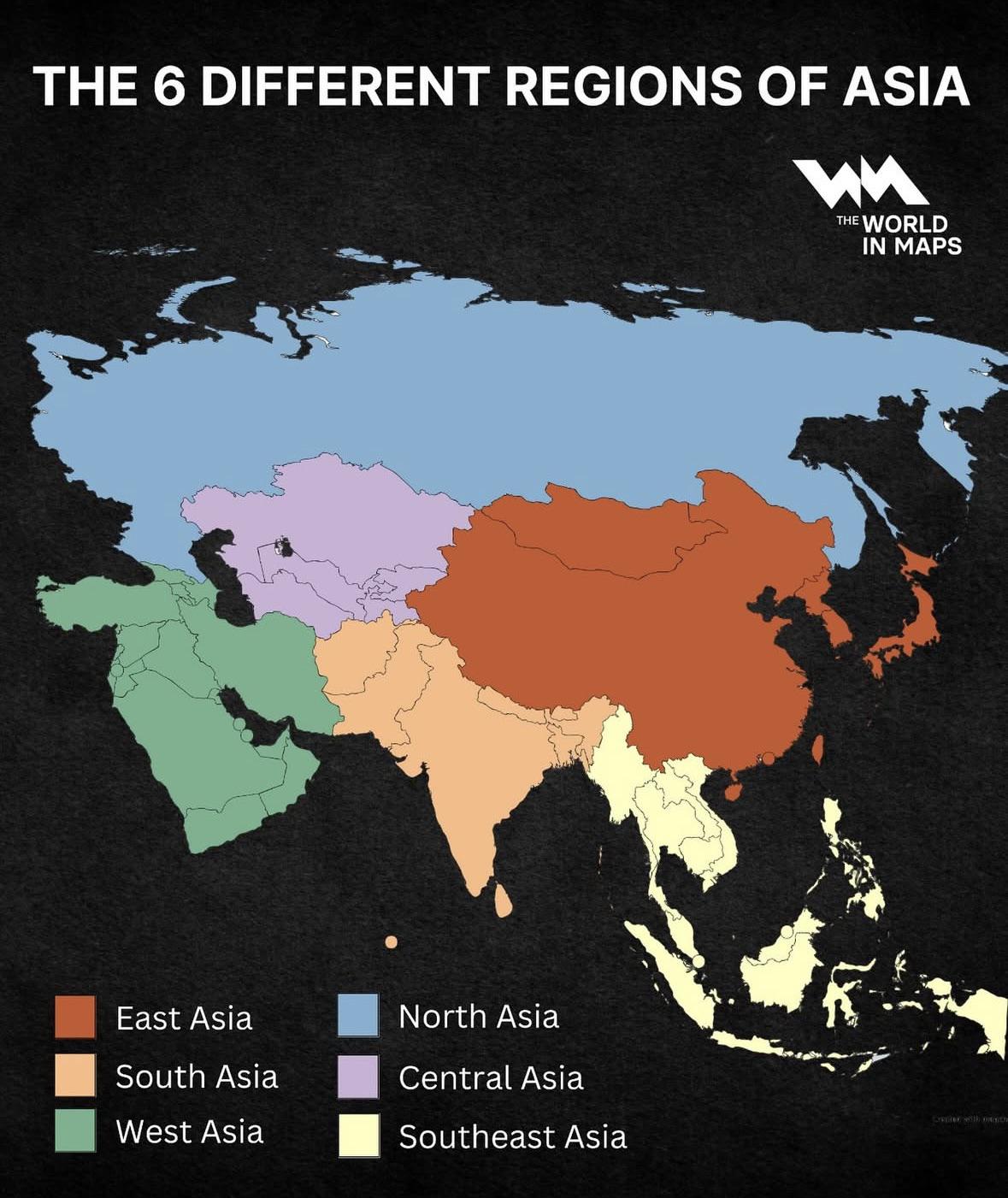Regions of Asia Map


Marcus Rodriguez
Historical Geography Expert
Marcus Rodriguez specializes in historical cartography and geographic data analysis. With a background in both history and geography, he brings unique...
Geographic Analysis
What This Map Shows
The "Regions of Asia Map" provides a comprehensive overview of the six distinct geographical regions that comprise the Asian continent. This visualization categorizes Asia into East Asia, Southeast Asia, South Asia, Central Asia, Western Asia, and North Asia, showcasing not only their geographical boundaries but also highlighting cultural, economic, and political differences that make each region unique. Understanding these regions is essential for grasping the complexity of the continent as a whole.
Deep Dive into the Regions of Asia
Asia is the largest continent in the world, covering about 44.58 million square kilometers and home to approximately 4.7 billion people, making it the most populous continent. Each region of Asia boasts diverse cultures, languages, and histories. Let's take a closer look at what defines each region:
- **East Asia** includes countries like China, Japan, South Korea, North Korea, Mongolia, and Taiwan. This region is known for its rapid economic development, technological advancements, and cultural exports such as cuisine, cinema, and fashion. China's economic rise has transformed it into a global powerhouse, while Japan remains a leader in technology and innovation. Interestingly, the cultural influence of East Asia can be traced back thousands of years, with rich traditions in art, philosophy, and governance.
- **Southeast Asia** consists of nations like Indonesia, Thailand, Vietnam, Malaysia, Singapore, and the Philippines. This vibrant region is characterized by its diverse cultures, ethnic groups, and languages. The economy of Southeast Asia has been rapidly growing, with tourism playing a significant role due to its stunning landscapes and rich history. Have you noticed how this region is a melting pot of cultures, where Hindu, Buddhist, and Islamic influences coexist? The region has also been a focal point for trade routes for centuries, connecting the East and West.
- **South Asia** includes India, Pakistan, Bangladesh, Nepal, Bhutan, Sri Lanka, and the Maldives. This region is marked by its diverse demographics, rich cultural heritage, and significant historical events. India, the largest country in South Asia, is known for its vast population and cultural diversity, with over 2,000 distinct ethnic groups and 1,600 spoken languages. What's fascinating is how South Asia's economic growth has been accompanied by significant challenges, such as poverty and political tensions, particularly between India and Pakistan.
- **Central Asia** features countries like Kazakhstan, Uzbekistan, Turkmenistan, Kyrgyzstan, and Tajikistan. This landlocked region is often referred to as the "Stans" and is known for its vast steppes, mountains, and rich history along the Silk Road. Central Asia is strategically important due to its location between major powers like Russia and China. The economies here are primarily based on natural resources, including oil and gas, and have been affected by geopolitical changes over the years.
- **Western Asia**, often synonymous with the Middle East, includes countries like Saudi Arabia, Iran, Iraq, Israel, and Jordan. This region is known for its rich history, being the cradle of civilization. The economies here are often heavily dependent on oil and gas exports, leading to significant wealth disparities. However, the region also faces challenges such as political instability and conflicts. Interestingly, the cultural and religious diversity in Western Asia adds to its complexity, with major world religions such as Islam, Christianity, and Judaism having deep roots here.
- **North Asia**, primarily represented by Siberia in Russia, is a sparsely populated region characterized by its harsh climate and vast landscapes. This area is rich in natural resources, including timber and minerals, but faces significant challenges due to its remote location and environmental conditions. The indigenous peoples of Siberia contribute to the region's cultural tapestry, although they often face challenges related to modernization and environmental degradation.
Regional Analysis
Analyzing these regions reveals stark contrasts and similarities. For instance, while East Asia is a leader in technological innovation, South Asia grapples with socio-economic issues despite its rich cultural heritage. Southeast Asia, with its blend of cultures, stands out for its tourism-driven economy, whereas Central Asia's resource dependency shapes its global interactions.
Interestingly, Western Asia's geopolitical landscape significantly affects global politics, with oil production playing a major role in international relations. In contrast, North Asia's vast, untapped resources present opportunities for future economic development, albeit at the risk of environmental concerns.
Significance and Impact
Understanding the regions of Asia is crucial for several reasons. Firstly, it helps in comprehending global economic patterns, as many Asian countries are emerging as major players on the world stage. For example, China and India are set to become the largest economies by 2030, influencing global trade dynamics.
Moreover, regional conflicts, such as those in Western Asia, have far-reaching implications, affecting international relations, migration patterns, and security policies worldwide. Current trends, such as the rise of nationalism and environmental challenges, further complicate the geopolitical landscape.
In conclusion, the regions of Asia are not just geographical divisions; they represent cultures, economies, and histories that shape the world we live in today. As we move forward, understanding these regions will be essential for addressing global challenges and fostering international cooperation.
Comments
Loading comments...